Papers by S. Joseph Wright
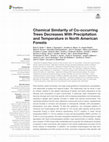
Plant diversity varies immensely over large-scale gradients in temperature, precipitation, and se... more Plant diversity varies immensely over large-scale gradients in temperature, precipitation, and seasonality at global and regional scales. This relationship may be driven in part by climatic variation in the relative importance of abiotic and biotic interactions to the diversity and composition of plant communities. In particular, biotic interactions may become stronger and more host specific with increasing precipitation and temperature, resulting in greater plant species richness in wetter and warmer environments. This hypothesis predicts that the many defensive compounds found in plants’ metabolomes should increase in richness and decrease in interspecific similarity with precipitation, temperature, and plant diversity. To test this prediction, we compared patterns of chemical and morphological trait diversity of 140 woody plant species among seven temperate forests in North America representing 16.2°C variation in mean annual temperature (MAT), 2,115 mm variation in mean annual p...
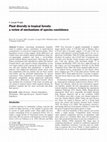
Oecologia, 2002
Evidence concerning mechanisms hypothesized to explain species coexistence in hyper-diverse commu... more Evidence concerning mechanisms hypothesized to explain species coexistence in hyper-diverse communities is reviewed for tropical forest plants. Three hypotheses receive strong support. Niche differences are evident from non-random spatial distributions along micro-topographic gradients and from a survivorshipgrowth tradeoff during regeneration. Host-specific pests reduce recruitment near reproductive adults (the Janzen-Connell effect), and, negative density dependence occurs over larger spatial scales among the more abundant species and may regulate their populations. A fourth hypothesis, that suppressed understory plants rarely come into competition with one another, has not been considered before and has profound implications for species coexistence. These hypotheses are mutually compatible. Infrequent competition among suppressed understory plants, niche differences, and Janzen-Connell effects may facilitate the coexistence of the many rare plant species found in tropical forests while negative density dependence regulates the few most successful and abundant species.
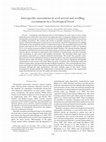
Ecology, 2016
Contagious seed dispersal refers to the tendency for some sites to receive many dispersed seeds w... more Contagious seed dispersal refers to the tendency for some sites to receive many dispersed seeds while other sites receive few dispersed seeds. Contagious dispersal can lead to interspecific associations in seed arrival, and this in turn might lead to interspecific associations in seedling recruitment. We evaluate the extent of spatially contagious seed arrival, the frequency of positive interspecific associations in seed arrival, and their consequences for seedling recruitment at the community level in a tropical moist forest. We quantified seed arrival to 200 passive seed traps for 28 yr of weekly censuses and seedling recruitment to 600 1-m 2 quadrats for 21 yr of annual censuses on Barro Colorado Island, Panama. We assessed whether spatially contagious seed dispersal was more important among zoochorous species than among anemochorous species, increased in importance with similarity in fruiting times, and led to interspecific associations in seed arrival and seedling recruitment. We controlled adult seed source associations statistically to evaluate predicted relationships. We found that spatially contagious seed arrival was widespread among zoochorous species, but also occurred among anemochorous species when the strong, consistent trade winds were present. Significant interspecific associations in seed arrival were more likely for pairs of species with zoochorous seeds and similar fruiting times and persisted through seedling recruitment. Thus, interspecifically contagious seed dispersal affects local species composition and alters the mixture of interspecific interactions through the seed, germination, and early seedling stages in this forest. Future investigations should consider the implications of interspecific association at the regeneration stages documented here for later life stages and species coexistence.
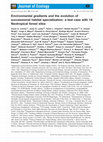
Journal of Ecology, 2015
1. Successional gradients are ubiquitous in nature, yet few studies have systematically examined ... more 1. Successional gradients are ubiquitous in nature, yet few studies have systematically examined the evolutionary origins of taxa that specialize at different successional stages. Here we quantify successional habitat specialization in Neotropical forest trees and evaluate its evolutionary lability along a precipitation gradient. Theoretically, successional habitat specialization should be more evolutionarily conserved in wet forests than in dry forests due to more extreme microenvironmental differentiation between early and late-successional stages in wet forest. 2. We applied a robust multinomial classification model to samples of primary and secondary forest trees from 14 Neotropical lowland forest sites spanning a precipitation gradient from 788 to 4000 mm annual rainfall, identifying species that are old-growth specialists and secondary forest specialists in each site. We constructed phylogenies for the classified taxa at each site and for the entire set of classified taxa and tested whether successional habitat specialization is phylogenetically conserved. We further investigated differences in the functional traits of species specializing in secondary vs. old-growth forest along the precipitation gradient, expecting different trait associations with secondary forest specialists in wet vs. dry forests since water availability is more limiting in dry forests and light availability more limiting in wet forests. 3. Successional habitat specialization is non-randomly distributed in the angiosperm phylogeny, with a tendency towards phylogenetic conservatism overall and a trend towards stronger conservatism in wet forests than in dry forests. However, the specialists come from all the major branches of the angiosperm phylogeny, and very few functional traits showed any consistent relationships with successional habitat specialization in either wet or dry forests. 4. Synthesis. The niche conservatism evident in the habitat specialization of Neotropical trees suggests a role for radiation into different successional habitats in the evolution of species-rich genera, though the diversity of functional traits that lead to success in different successional habitats complicates analyses at the community scale. Examining the distribution of particular lineages with respect to successional gradients may provide more insight into the role of successional habitat specialization in the evolution of species-rich taxa.
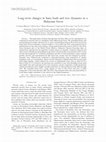
Ecology, 2015
The importance of lianas through time and their effect on tree reproduction are evaluated for the... more The importance of lianas through time and their effect on tree reproduction are evaluated for the first time in a Southeast Asian Dipterocarp forest. We quantified flower and seed production by lianas and trees for 13 years, assessed liana loads in the crowns of all trees larger than 30 cm in diameter at breast height (1.3 m) in 2002 and 2014, and assessed levels of reproduction for the same trees during a strong general flowering event in 2014 for the 50-ha forest dynamics plot at the Pasoh Forest Reserve, Malaysia. General flowering refers to synchronous reproduction by hundreds of plant species at irregular, multiyear intervals and only occurs in Southeast Asian Dipterocarp forests. Overall, lianas were present in 50% of tree crowns and comprised 31% of flower production and 46% of seed production. Lianas reduced growth, survival, and reproduction by their host trees. Lianas were less frequent in canopyemergent trees, Dipterocarps comprised a disproportionately large proportion of canopy emergents, and, as a consequence, lianas were less frequent in Dipterocarps than in trees from other plant families. Lianas infested the crowns of significantly fewer trees in 2014 (47.9%) than in 2002 (52.3%); however, the decrease was restricted to trees with the lightest liana loads and sample sizes and statistical power were enormous. Lianas comprised a stable proportion of flower production and a highly variable proportion of seed production from 2002 through 2013. We conclude lianas have a huge impact on trees in this forest and were a stable component of the forest between 2002 and 2014. The emergent habit and associated ability to avoid lianas might contribute to the success of the Dipterocarpaceae.
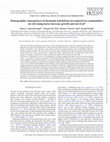
Annals of botany, 2013
Many tropical forest tree species delay greening their leaves until full expansion. This strategy... more Many tropical forest tree species delay greening their leaves until full expansion. This strategy is thought to provide newly flushing leaves with protection against damage by herbivores by keeping young leaves devoid of nutritive value. Because young leaves suffer the greatest predation from invertebrate herbivores, delayed greening could prevent costly tissue loss. Many species that delay greening also produce anthocyanin pigments in their new leaves, giving them a reddish tint. These anthocyanins may be fungicidal, protect leaves against UV damage or make leaves cryptic to herbivores blind to the red part of the spectrum. A comprehensive survey was undertaken of seedlings, saplings and mature trees in two diverse tropical forests: a rain forest in western Amazonia (Yasuní National Park, Ecuador) and a deciduous forest in Central America (Barro Colorado Island, Panamá). A test was made of whether individuals and species with delayed greening or red-coloured young leaves showed low...
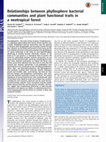
Proceedings of the National Academy of Sciences of the United States of America, Jan 23, 2014
The phyllosphere--the aerial surfaces of plants, including leaves--is a ubiquitous global habitat... more The phyllosphere--the aerial surfaces of plants, including leaves--is a ubiquitous global habitat that harbors diverse bacterial communities. Phyllosphere bacterial communities have the potential to influence plant biogeography and ecosystem function through their influence on the fitness and function of their hosts, but the host attributes that drive community assembly in the phyllosphere are poorly understood. In this study we used high-throughput sequencing to quantify bacterial community structure on the leaves of 57 tree species in a neotropical forest in Panama. We tested for relationships between bacterial communities on tree leaves and the functional traits, taxonomy, and phylogeny of their plant hosts. Bacterial communities on tropical tree leaves were diverse; leaves from individual trees were host to more than 400 bacterial taxa. Bacterial communities in the phyllosphere were dominated by a core microbiome of taxa including Actinobacteria, Alpha-, Beta-, and Gammaproteoba...
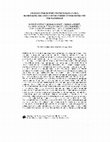
Environmental Monitoring and Assessment, 2002
The goals were to establish baseline indicators for the integrity of forest communities and river... more The goals were to establish baseline indicators for the integrity of forest communities and rivers. Based on satellite image classification and ground surveys, the 2790 km 2 watershed had 1570 km 2 of forest in 1997, 1080 km 2 of which was in national parks and nature monuments. Most of the 490 km 2 of forest not currently in protected areas lies along the west bank of the Canal, and its management status after the year 2000 turnover of the Canal from the U.S. to Panama remains uncertain. In forest plots designed to monitor forest diversity and change, a total of 963 woody plant species were identified and mapped. We estimate there are a total of 850-1000 woody species in forests of the Canal corridor. Forests of the wetter upper reaches of the watershed are distinct in species composition from the Canal corridor, and have considerably higher diversity and many unknown species. These remote areas are extensively forested, poorly explored, and harbor an estimated 1400-2200 woody species. Vertebrate monitoring programs were also initiated, focusing on species threatened by hunting and forest fragmentation. Large mammals are heavily hunted in most forests of Canal corridor, and there was clear evidence that mammal density is greatly reduced in hunted areas and that this affects seed predation and dispersal. The human population of the watershed was 113 000 in 1990, and grew by nearly 4% per year from 1980 to 1990. Much of this growth was in a small region of the watershed on the outskirts of Panama City, but even rural areas, including villages near and within national parks, grew by 2% per year. There is no sewage treatment in the watershed, and many towns have no trash collection, thus streams near large towns are heavily polluted. Analyses of sediment loads in rivers throughout the watershed did not indicate that erosion has been increasing as a result of deforestation, rather, erosion seems to be driven largely by total rainfall and heavy rainfall events that cause landslides. Still, models suggest that large-scale deforestation would increase landslide frequency, and failure to detect increases in erosion could be due to the gradual deforestation rate and the short time period over which data are available. A study of runoff showed deforestation increased the amount of water from rainfall that passed directly into streams. As a result, dry season flow was reduced in a deforested catchment relative to a forested one. Currently, the Panama Canal watershed has extensive forest areas and streams relatively unaffected by humans. But impacts of hunting and
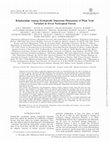
† Background and Aims When ecologically important plant traits are correlated they may be said to... more † Background and Aims When ecologically important plant traits are correlated they may be said to constitute an ecological 'strategy' dimension. Through identifying these dimensions and understanding their interrelationships we gain insight into why particular trait combinations are favoured over others and into the implications of trait differences among species. Here we investigated relationships among several traits, and thus the strategy dimensions they represented, across 2134 woody species from seven Neotropical forests. † Methods Six traits were studied: specific leaf area (SLA), the average size of leaves, seed and fruit, typical maximum plant height, and wood density (WD). Trait relationships were quantified across species at each individual forest as well as across the dataset as a whole. 'Phylogenetic' analyses were used to test for correlations among evolutionary trait-divergences and to ascertain whether interspecific relationships were biased by strong taxonomic patterning in the traits. † Key Results The interspecific and phylogenetic analyses yielded congruent results. Seed and fruit size were expected, and confirmed, to be tightly related. As expected, plant height was correlated with each of seed and fruit size, albeit weakly. Weak support was found for an expected positive relationship between leaf and fruit size. The prediction that SLA and WD would be negatively correlated was not supported. Otherwise the traits were predicted to be largely unrelated, being representatives of putatively independent strategy dimensions. This was indeed the case, although WD was consistently, negatively related to leaf size. † Conclusions The dimensions represented by SLA, seed/fruit size and leaf size were essentially independent and thus conveyed largely independent information about plant strategies. To a lesser extent the same was true for plant height and WD. Our tentative explanation for negative WD-leaf size relationships, now also known from other habitats, is that the traits are indirectly linked via plant hydraulics.
Science, 2011
The ratio of stable isotopes in leaves and wood reveals an increase in nitrogen availability in P... more The ratio of stable isotopes in leaves and wood reveals an increase in nitrogen availability in Panamanian and Thai tropical forests.
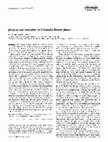
Oecologia, 1987
We tested for intraspecific interference among Colorado Desert shrubs using an integrated analysi... more We tested for intraspecific interference among Colorado Desert shrubs using an integrated analysis of spatial pattern and juvenile mortality. The data set included 7,000 woody perennials of 24 species in a mapped hectare of Joshua Tree National Monument, California. The site is dominated by Ambrosia dumosa (62.0% of the stems), with Larrea tridentata a conspicuous secondary species (2.3% of the stems). Analyses of static pattern for common species showed: (1) aggregated adults and juveniles for Ambrosia dumosa, Erigonum fasciculatum, Mirabilis bigelovii, and Sphaeralcea ambigua, with more aggregation among juveniles than adults; (2)randomly distributed adults and juveniles for Krameria grayi, Opuntia rasmosissima, Simondsia chinensis, and Yucca schidigera. The summed volumes and distances between nearest conspecific neighbors were positively correlated for Ambrosia dumosa and Larrea tridentata, but not significantly correlated for eight remaining species with > 100 individuals. Static pattern suggests only weak evidence for negative interactions in Ambrosia and Larrea, and little evidence for other species. Alternative mechanisms other than negative interaction that could give rise to these static patterns are discussed. Juvenile mortality was documented for four common species (Ambrosia dumosa, Eriogonum fasciculatum, Mirabilis bigelovii, and Sphaeraleea ambigua) that experienced substantial mortality. Analyses show: (l)the proportion of individuals that died was independent of the initial density of conspecifics; (2) distance to conspecific adults did not differ for juveniles that died versus those that survived; and (3) death was no more likely for juveniles that contacted other plants than for those that were isolated. The exception was a vine, Mirabilis bigelovii, whose juveniles survived better in contact with other plants. In sum, neither spatial pattern nor patterns of mortality showed clear evidence of negative intraspecific interference.

Oecologia, 1991
Factors affecting seedling Virola surinamensis (Myristicaceae) survival and growth were investiga... more Factors affecting seedling Virola surinamensis (Myristicaceae) survival and growth were investigated on Barro Colorado Island, Panama. Seedlings planted 3 months after germination were monitored in treefall gaps and understory using 2.25 ha irrigated and control plots through the first dry season. During the dry season, irrigated plants in gaps increased total leaf area significantly more than did irrigated plants in the shaded understory. Over the same dry season, control plants in gaps and in the shaded understory lost similar amounts of leaf area. Seedlings in understory were suppressed in stem height and biomass in both irrigated and control plots; these measures were greater in gaps and greatest in irrigated gaps (height). Roots were similar in length in all treatments, but greater in biomass in gaps than understory due to greater proliferation of secondary roots in control and irrigated gaps than in control and irrigated understory. This experiment demonstrates both water and light limitation during the first dry season after germination. V. surinamensis seedlings are capable of survival and modest growth of leaf area in the deep shade of the understory in moist locations; they are severely disadvantaged in shaded understory subject to drought, where most seeds fall and most seedlings establish. The broken canopy of a gap allows shoot and consequently root growth that permits seedlings to survive seasonal drought.
Oecologia, 2004
Coordinated changes in photosynthesis, water relations and leaf nutritional traits of canopy tree... more Coordinated changes in photosynthesis, water relations and leaf nutritional traits of canopy trees along a precipitation gradient in lowland tropical forest, 139
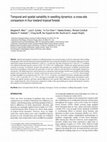
Journal of Tropical Ecology, 2008
Spatial and temporal variation in seedling dynamics was assessed using records of community-wide ... more Spatial and temporal variation in seedling dynamics was assessed using records of community-wide seedling demography collected with identical monitoring methods at four tropical lowland forests in Panama, Malaysia, Ecuador and French Guiana for periods of between 3 and 10 y. At each site, the fates of between 8617 and 391 777 seedlings were followed through annual censuses of the 370-1008 1-m 2 seedling plots. Within-site spatial and inter-annual variation in density, recruitment, growth and mortality was compared with among-site variability using Bayesian hierarchical modelling to determine the generality of each site's patterns and potential for meaningful comparisons among sites. The Malaysian forest, which experiences community-wide masting, was the most variable in both seedling density and recruitment. However, density varied year-to-year at all sites (CV among years at site = 8-43%), driven largely by high variability in recruitment rates (CV = 40-117%). At all sites, recruitment was more variable than mortality (CV = 5-64%) or growth (CV = 12-51%). Increases in mortality rates lagged 1 y behind large recruitment events. Within-site spatial variation and inter-annual differences were greater than differences among site averages in all rates, emphasizing the value of long-term comparative studies when generalizing how spatial and temporal variation drive patterns of recruitment in tropical forests.
Plant Ecology, 1998
Spatial pattern and patterns of mortality were analyzed from a five year re-census of over 7000 m... more Spatial pattern and patterns of mortality were analyzed from a five year re-census of over 7000 mapped perennial shrubs within a one hectare study plot in Joshua Tree National Park. A five year interval revealed evidence for negative intraspecific interactions which was not evident after a one year evaluation of the same plants within the study area. Juvenile mortality was
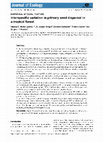
Journal of Ecology, 2008
1. We investigated the relationships of seed size, dispersal mode and other species characteristi... more 1. We investigated the relationships of seed size, dispersal mode and other species characteristics to interspecific variation in mean primary seed dispersal distances, mean annual seed production per unit basal area, and clumping of seed deposition among 41 tropical tree species on Barro Colorado Island, Panama. 2. A hierarchical Bayesian model incorporating interannual variation in seed production was used to estimate seed dispersal, seed production, and clumping of seed rain for each species from 19 years of data for 188 seed traps on a 50-ha plot in which all adult trees were censused every 5 years. 3. Seed dispersal was modelled as a two-dimensional Student's T distribution with the degrees of freedom parameter fixed at 3, interannual variation in seed production per basal area was modelled as a lognormal, and the clumping of seed rain around its expected value was modelled as a negative binomial distribution. 4. There was wide variation in seed dispersal distances among species sharing the same mode of seed dispersal. Seed dispersal mode did not explain significant variation in seed dispersal distances, but did explain significant variation in clumping: animal-dispersed species showed higher clumping of seed deposition. 5. Among nine wind-dispersed species, the combination of diaspore terminal velocity, tree height and wind speed in the season of peak dispersal explained 40% of variation in dispersal distances. Among 31 animal-dispersed species, 20% of interspecific variation in dispersal distances was explained by seed mass (a negative effect) and tree height (a positive effect). 6. Among all species, seed mass, tree height and dispersal syndrome explained 28% of the variation in mean dispersal distance and seed mass alone explained 45% of the variation in estimated seed production per basal area. 7. Synthesis. There is wide variation in patterns of primary seed rain among tropical tree species. Substantial proportions of interspecific variation in seed production, seed dispersal distances, and clumping of seed deposition are explained by relatively easily measured plant traits, especially dispersal mode, seed mass, and tree height. This provides hope for trait-based generalization and modelling of seed dispersal in tropical forests.
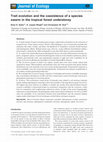
Journal of Ecology, 2012
1. A small number of species-rich plant genera make a substantial contribution to the a diversity... more 1. A small number of species-rich plant genera make a substantial contribution to the a diversity of tropical forests. These 'species swarms' (Gentry 1982) challenge a view of community assembly that maintains that niche overlap, and hence, the likelihood of competitive exclusion should increase with phylogenetic affinity. Related species may, however, occupy different microhabitats within a forest stand or, alternatively, differ ecologically in ways that allow them to coexist syntopically. 2. To explore the relationship between phylogenetic history and niche differentiation among sympatric, congeneric species, we performed phylogenetic analyses of microhabitat preferences, photosynthetic and hydraulic traits, and experimental responses to light and water availability for 20 species of Psychotria (Rubiaceae) from Barro Colorado Island (BCI), Panama. 3. The Psychotria present in small (3-m radius), circular plots were more closely related than expected by chance. Photosynthetic and hydraulic traits were both associated with species habitat distributions, but only hydraulic traits were conserved phylogenetically. Experimental responses to water availability were also conserved phylogenetically. Functional trait analyses revealed little or no evidence of niche partitioning within sites. 4. We conclude that Psychotria species' responses to both light and moisture availability determine their microhabitat distributions on BCI and that evolutionarily conserved hydraulic traits lead to phylogenetic clustering of co-occurring species. 5. Synthesis. The evolutionary conservation of hydraulic traits related to soil moisture tolerance largely explains phylogenetic clustering in the local assembly of the hyperdiverse genus Psychotria. We suggest that close relatives are unlikely to exclude one another from shared habitats because resource availability is determined largely by asymmetric competition with the overstorey, rather than by competition with neighbouring understorey plants. In light of the recent biogeographic admixture in central Panama, the phylogenetic niche conservatism exhibited by Psychotria on BCI raises the possibility of an association between local microhabitats and the ancestral climatic regimes under which major Psychotria lineages evolved before arriving in sympatry.
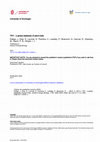
Global Change Biology, 2011
Plant traits-the morphological, anatomical, physiological, biochemical and phenological character... more Plant traits-the morphological, anatomical, physiological, biochemical and phenological characteristics of plants and their organs-determine how primary producers respond to environmental factors, affect other trophic levels, influence ecosystem processes and services and provide a link from species richness to ecosystem functional diversity. Trait data thus represent the raw material for a wide range of research from evolutionary biology, community and functional ecology to biogeography. Here we present the global database initiative named TRY, which has united a wide range of the plant trait research community worldwide and gained an unprecedented buy-in of trait data: so far 93 trait databases have been contributed. The data repository currently contains almost three million trait entries for 69 000 out of the world's 300 000 plant species, with a focus on 52 groups of traits characterizing the vegetative and regeneration stages of the plant life cycle, including growth, dispersal, establishment and persistence. A first data analysis shows that most plant traits are approximately log-normally distributed, with widely differing ranges of variation across traits. Most trait variation is between species (interspecific), but significant intraspecific variation is also documented, up to 40% of the overall variation. Plant functional types (PFTs), as commonly used in vegetation models, capture a substantial fraction of the observed variation-but for several traits most variation occurs within PFTs, up to 75% of the overall variation. In the context of vegetation models these traits would better be represented by state variables rather than fixed parameter values. The improved availability of plant trait data in the unified global database is expected to support a paradigm shift from species to trait-based ecology, offer new opportunities for synthetic plant trait research and enable a more realistic and empirically grounded representation of terrestrial vegetation in Earth system models.
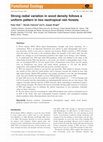
Functional Ecology, 2013
1. Wood density (WD) affects plant biomechanics, drought and decay resistance. As a consequence, ... more 1. Wood density (WD) affects plant biomechanics, drought and decay resistance. As a consequence, WD is an important functional trait related to plant demography and ecosystem processes, which is also used to estimate tree biomass. Radial variation in WD (changes from the centre of the stem to the cambium) affects the strength of the entire stem, but also reflects any changes in wood functional properties that might occur during a tree's lifetime. 2. To understand how WD and radial WD gradients, which were defined as the slope of the relationship between WD and distance to the centre, are related to demographic traits of species, we investigated WD in 335 tree species from a Panamanian moist forest and 501 species from an Ecuadorian rain forest and radial density gradients in 118 and 186 species, respectively, and compared WD with tree growth, mortality and size. 3. WD was negatively related to tree growth and mortality. WD tended to increase towards the outside in trees with low initial density and to decrease towards the outside in trees with high initial density. Radial WD gradients were largely unrelated to tree size and demographic traits, but some families had higher or lower WD gradients at a given inner WD. 4. Inner WD was by far the best predictor of radial WD gradients (r 2 = 0Á39 for Panama and 0Á45 for Ecuador) and this relationship was indistinguishable between the two rain forests. This suggests a broadly uniform function of WD variation, likely responding to mechanical requirements during ontogeny. We discuss the factors potentially driving radial increases or decreases in WD and suggest ways to elucidate the relative importance of tree mechanics, hydraulic safety or decay resistance. 5. We also discuss that not accounting for radial WD gradients may result in substantial errors in WD of the whole stem and consequently biomass estimates, and recommend sampling density gradients when obtaining density data from tree cores.
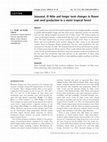
Ecology Letters, 2005
It has recently been reported that humid tropical forests are changing rapidly in response to glo... more It has recently been reported that humid tropical forests are changing rapidly in response to global anthropogenic change and that these forests experience greater tree mortality and even fire during droughts associated with El Niño events. The former reports are controversial largely because a single method has been used-repeated censuses of tree plots. The latter reports focus on recent extreme El Niño events. Here, we show that flower and seed production both increase during El Niño events in an old-growth tropical forest in Panama. Flower production, but not seed production, has also increased over the past 18 years. The sustained increase in flower production was greater for 33 liana species than for 48 tree species. These results indicate that moderate El Niño events favour seed production, document long-term increases in flower production for the first time, and corroborate long-term increases in the importance of lianas using independent methods. Changes in levels of solar irradiance might contribute to all three patterns.

Uploads
Papers by S. Joseph Wright